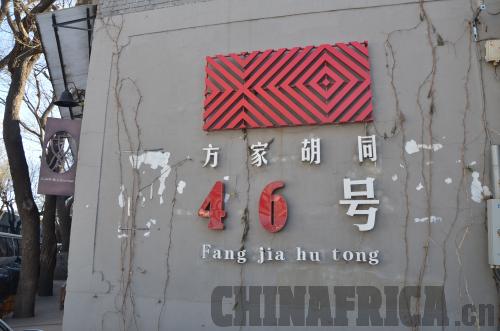| 
Some people love Beijing for its modern charm, while others are drawn by the allure of its past. In this respect, Beijing's hutongs - alleys with traditional courtyard residences that perfectly represent the city's old lifestyle - are particularly famous.
While hundreds of hutongs, after rounds of urban improvement though, can still be found in the central area of the city, the old architecture - usually with a shared lavatory and no bath - is losing appeal for residents as modern high-rises come up. But hutongs' unique beauty is being increasingly appreciated by artists, designers and creative people. As a result, hutong art zones have begun to emerge.
Before it became famous in artistic circles as an art zone, Courtyard No.46 Fangjia Hutong in Dongcheng District had been abandoned for decades. Then in 2008, it was revitalized by an art zone program and now boasts contemporary art studios, galleries and cafes. Located in a bystreet that probably dates back to the Yuan Dynasty (1271-1368), the courtyard, too, enjoys a rich though checkered past. Originally built as a British iron factory, it was turned into a Japanese military factory during World War II. When the People's Republic of China was founded in 1949, it was transformed into a machine tool factory and was abandoned later.
The courtyard redolent of old memories and the tranquil and traditional neighborhood - the famous Yonghe Lama Temple and Imperial Academy are nearby - are the reasons creative people are fascinated by the hutong.
"It gives you a feeling of being in Beijing," said Chen Yingze, an architect who relocated her studio three years ago to the rusty factory after getting tired of working in fancy office buildings.
"The problem with these modern offices is that they are too comfortable," Chen explained. "Everything is so perfectly organized. You might enjoy it the first few years till the conveniences eventually become restrictions." She believes her new old loft-style office with high ceilings can provide both abundant space for her daily work and inspiration.
The courtyard housing an auditorium, several offices, workshops and a boiler room is home to over 50 studios and workshops. It also showcases a stylish lifestyle with culture salons, galleries, cafes and bars.
The old boiler room in the center now houses Trainspotting, a movie-themed restaurant, or a restaurant-themed theater. As one of the earliest culture salons in Beijing, Trainspotting's screening of films - every Saturday night there is a free open-air show - has made it an important platform for young independent directors to present their films and communicate with their audience.
Part of the audiences and customers, unsurprisingly, comes from "within," like Xiao Xue, who runs a tea house in the courtyard. She works and spends her time in Courtyard No.46 Fangjia Hutong, where everything she needs can be found easily: coffee or tea for an idle afternoon, a movie for a summer night, boutiques to shop around, and even a trendy hotel to accommodate visiting friends.
"It's a community," concluded Chen's friend Casey McSweeney, an architect who moved to Beijing five years ago and now works in the courtyard. People in this community share similar interests. "You can walk out anytime and find someone to have an interesting and inspiring conversation with," he added.
Courtyard No.46 is not the first program to revitalize and capitalize on the city's industrial relics. When it was launched in 2008, it was dubbed "mini 798" after the city's earliest and most well-known art zone, 798 Art District.
Inspired by the SOHO area in New York City which became a haven for artists in the 1960s and 1970s, 798 Art District, previously a state-owned industrial plant lying on the northern outskirts of Beijing, opened its door to artists in 2000. Numerous galleries and studios filled the abandoned warehouse, soon making it a center for all kinds of art events and the most important part of Beijing's contemporary art scene.
The success of 798 Art District triggered an art zone boom in the country. Similar programs sprouted in big cities like Shanghai, Guangzhou and Shenzhen. However, over one and a half decade since its birth, 798 Art District has seemingly changed. Art needs audience but things get out of control when it gets too much attention from the public. Instead of nurturing art, 798 Art District has become another must-visit spot for tourists with the number of souvenir shops almost surpassing that of studios and galleries.
"It's always noisy like a temple fair," Chen said. The rents have surged and the far-flung location has added to the disadvantages, making some of the artists leave 798. Will the same fate befall Courtyard No.46 Fangjia Hutong?
"It's much smaller and is tucked away in an old neighborhood, which means there won't be too many visitors," Chen said. "If people want to have fun, they will go to nearby Wudaoying Hutong, another artsy area near the main road and filled with restaurants and shops."
At least one thing is certain though. Courtyard No.46 Fangjia Hutong, irrespective of its future, is not the first art zone in Beijing; nor will it be the last.
|